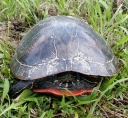Northern Red-Bellied Cooter (Pseudemys rubriventris)
Description: The carapaces of adult red-bellied turtles are on average 10 to 12.5 inches in length. The carapace is a mahogany black color with red lines running dorso-ventrally. They have a serrated front upper-jaw. The head is brown and arrow-shaped with a yellow line that extends between the eyes and snout. A series of consecutive thick and thin yellow bands come off the anterior of the eye and travel laterally down the neck. This species exhibits sexual dimorphism. The plastrons of male red-bellied turtles are light pink. They have long, straight claws on their feet and an anal opening that extends beyond the shell. The females are larger than the males with brighter red plastrons containing gray borders. The hatchlings of P. rubriventris have an orange plastron and a green carapace covered with light green markings. The skin is light green as well.
Habitat: Eastern red-bellied turtles inhabit large freshwater lakes, rivers, ponds, and creeks. Most of these waters are fast moving, deep-bodied, and contain a muddy bottom where the water depth ranges from 6 ot 10 feet. Occasionally, P. rubriventris are found in brackish water at the mouths of rivers. They surround themselves with aquatic vegetation, rocks, and logs for basking in the sun. Eastern red-bellied turtles become terrestrial for short periods of time while laying eggs in June or July. They show little evidence of migration and often occupy the same habitat year-round.
Range: The range of Pseudemys rubriventris spans the Mid-Atlantic coastal waters of the USA from New Jersey to North Carolina. This includes areas east to the Potomac River and west to W. Virginia. There is a disjunctive population of eastern red-bellied turtles in Massachusetts, as well as a small, introduced population in Long Island, New York.
Diet: Red-bellied turtles primarily eat aquatic vegetation and algae such as Myriophyllum, Utricularia, and Sagittaria. Secondary food sources include crayfish, snails, fish, and tadpoles. Juveniles are herbivorous and adults are omnivorous. Laboratory hatchlings can be fed brine shrimp.
Reproduction: The mating of P. rubriventris has never been observed. Scientists know mating does occur in shallow water in the fall or spring. With regards to a closely related species, Pseudemys concinna, the male pursues the female and sniffs her tail after the female releases a pheromone. In the following mating ritual, he then swims above and in front of her in the water and rapidly strokes her face with his claws. If a female P. concinna accepts his advances, the male then swims behind the female, mounting her for copulation.
Female eastern red-bellied turtles dig a nest cavity 4 inches wide by 4 inches deep in the sand in early June or July. This nest cavity is found in a well-insulated area 300 feet from the water, and 3 feet above pond level. Pseudemys rubriventris produce one clutch of eggs yearly containing 8 to 22 eggs. Hatching occurs in 73 to 80 days. The hatchlings emerge from August to October. If late nesting occurs, hatchlings do not emerge before the winter. Eggs incubated on natural sand are larger and have a better chance of survival than eggs incubated in artificial settings. Due to the loss of natural habitats, female red-bellied turtles sometimes lay eggs in homeowner's yards. Females try to return to the same nesting sights every year.
Status: The red-bellied turtle is a threatened species within Pennsylvania. However, it is listed as "Endangered" by the US Fish and Wildlife Service as well as the Division of Fisheries and Wildlife (Massachusetts).
The potential threats to red-bellied turtle populations are numerous. For example: wetland loss, habitat fragmentation, pollution, collecting of turtles for pets, food or other trophies, competition with the invasive red-eared slider turtle for food, habitat, basking sites or nesting sites, and the potential for hybridization with red-eared slider turtles.v
The Massachusetts wildlife preserve foundation has started to repopulate the turtles by placing them in many south-eastern Massachusetts ponds. One example is at Long and Little Long Pond in Plymouth, Massachusetts, where the population is starting to regrow.
»» Kingdom: Animalia - Animals
»» Phylum: Chordata - Chordates
»» Subphylum: Vertebrata - Vertebrates
»» Class: Reptilia - Reptiles
»» Order: Testudines - Turtles & Tortoises
»» Family: Emydidae - Pond, Marsh, & Box Turtles
»» Genus: Pseudemys
»» Species: Pseudemys rubriventris - Northern Red-Bellied Cooter
»» Subspecies: None
This article uses material from the Wikipedia article "Northern Red-Bellied Cooter", which is released under the Creative Commons Attribution-Share-Alike License 3.0. Content may have been omitted from the original, but no content has been changed or extended.
|








